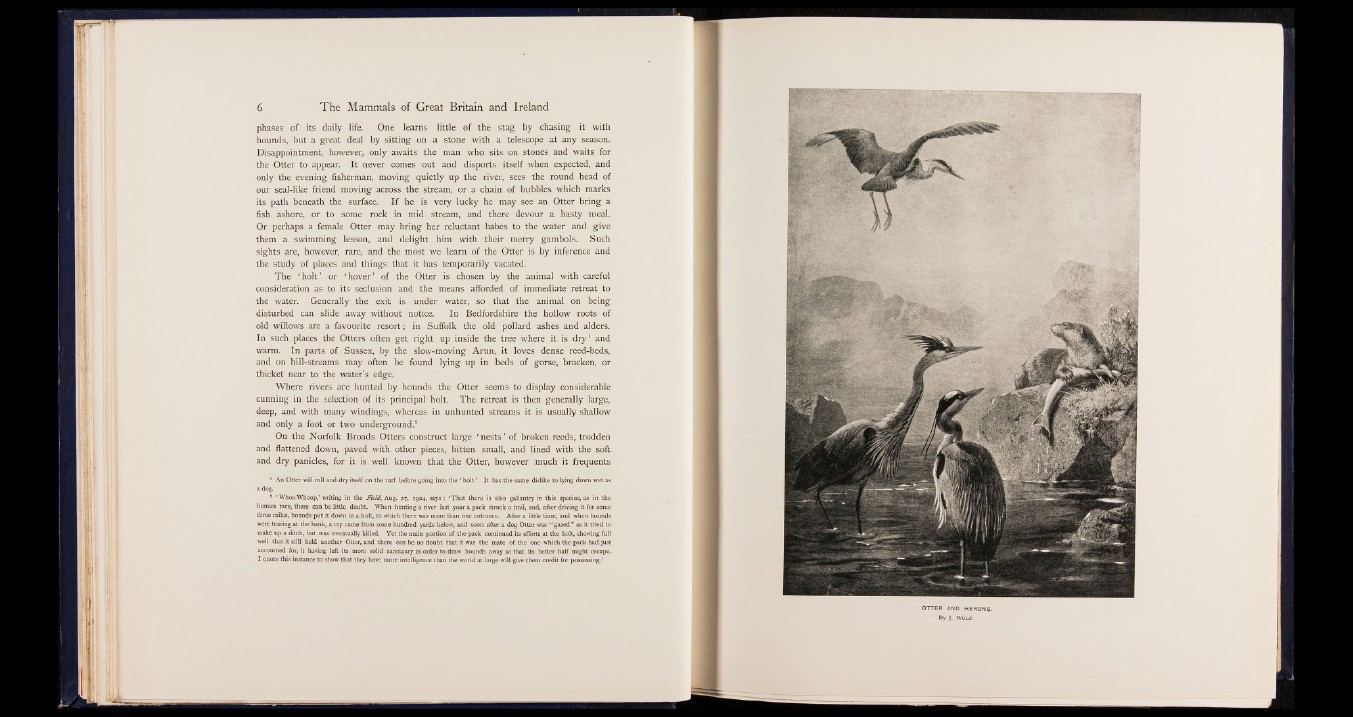
phases of its daily life. One learns little of the stag by chasing it with
hounds, but a great deal by sitting on a stone with a telescope at any season.
Disappointment, however, only awaits the man who sits on stones and waits for
the Otter to appear. It never comes out and disports itself when expected, and
only the evening fisherman, moving quietly up the river, sees the round head of
our seal-like friend moving across the stream, or a chain of bubbles which marks
its path beneath the surface, i I f he is very lucky he may see an Otter bring a
fish ashore, or to some rock in mid stream, and there devour a hasty meal.
Or perhaps a female Otter may bring her reluctant babes to the water and give
them a swimming lesson, and delight him with their merry gambols. Such
sights are, however, rare, and the most we learn of the Otter is by inference and
the study of places and things that it has temporarily vacated.
The ‘ holt’ or ‘ hover’ of the Otter is chosen by the animal with careful
consideration as to its seclusion and the means afforded of immediate retreat to
the water. Generally the exit is under water, so that the animal on being
disturbed can slide away without notice. In Bedfordshire the hollow roots of
old willows are a favourite resort; in Suffolk the old pollard ashes and alders.
In such places the Otters often get right up inside the tree where it is dry1 and
warm. In parts of Sussex, by the slow-moving Arun, it loves dense reed-beds,
and on hill-streams may often be found lying up in beds of gorse, bracken, or
thicket near to the water’s edge.
Where rivers are hunted by hounds the Otter seems to display considerable
cunning in the selection of its principal holt. The retreat is then generally large,
deep, and with many windings, whereas in unhunted streams it is usually shallow
and only a foot or two underground.2
On the Norfolk Broads Otters construct large ‘ nests ’ of broken reeds, trodden
and flattened down, paved with other pieces, bitten small, and lined with the soft
and dry panicles, for it is well known that the Otter, however much it frequents
1 An Otter will roll and dry itself on the turf before going into the ‘ holt.’ It has the same dislike to lying down wet as
* ‘ Whoa-Whoop,’ writing in the Field, Aug. 27, 1904, says : ‘ That there is also gallantry in this species, as in the
human race, there can be little doubt. When hunting a river last year a pack struck a trail, and, after driving it for some
three miles, hounds put it down in a holt, to which there was more than one entrance. After a little time, and when hounds
were tearing at the bank, a cry came from some hundred yards below, and soon after a dog Otter was “ gazed ” as it tried to
make up a ditch, but was eventually killed. Yet the main portion of the pack continued its efforts at the holt, showing full
well that it still held another Otter, and there can be no doubt that it was the mate of the one which the pack had just
accounted for, it having left its more solid sanctuary in order to draw hounds away so that its better half might escape.
I quote this instance to show that they have more intelligence than the world at large will give them credit for possessing.’